Hyde
Hyde Town Centre
Services in Hyde
Tameside Image Archive
Take a look at the historical images of Tameside we have available.
Hyde Town Hall
Information on the town hall, its amenities, events, and hiring it as a venue.
Werneth Low Country Park
Information on Werneth Low country park, including rules, walks, amenities and more.
Coat of Arms
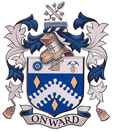 Argent, a chevron nebuly argent between three lozenges Or; on a chief of the second a flake erect surmounted by a hatter's bow in bend sinister between a cog-wheel and two miners' pick in saltire, therefrom suspended a Davy lamp, all proper. Crest: On a wreath of the colours,
Argent, a chevron nebuly argent between three lozenges Or; on a chief of the second a flake erect surmounted by a hatter's bow in bend sinister between a cog-wheel and two miners' pick in saltire, therefrom suspended a Davy lamp, all proper. Crest: On a wreath of the colours,
Upon a pack of cotton prints azure, banded and semee of mascles Or, a sprig of the cotton-tree, slipped and fructed, in bend sinister surmounted of a shuttle furnished in bend proper. Motto: Onward. Granted: 18 July 1882.
The Arms reflects the reasons for its establishment as an independent town - its industry. Cotton is shown by the cotton pattern and shuttle, coal by the miner's axe and the Davy lamp, and hatting by the hatters bow. The lower part of the shield contained the Arms of the manorial family of Hyde.
History of Hyde
Early History
Its name derives from "hide" meaning a measure of land roughly equivalent to 120 acres. The town is largely a creation of the 19th century and the Industrial Revolution. In the late 18th century the area that was to become the town centre was no more than a cluster of houses known as Red Pump Street. Gee Cross was much larger and "Hyde" was still only used to refer to the estates of Hyde Hall on the banks of the Tame. Altogether there were only 3,500 inhabitants in the district in 1801.
Hyde's growth was inseparable from that of the cotton industry. As the town's historian, Thomas Middleton, said "Prior to its connections with the cotton industry, Hyde has no separate identity It was merely an outlying township of the Parish of Stockport". As new mills were erected, cottages were built to house the workers and these hamlets gradually grew together to form Hyde. The name appears to have come into common usage by 1830. Significantly, Hyde received its first Anglican place of worship, St George's, in 1832. Dissenting churches existed prior to this, notably the Unitarian Chapel at Gee Cross dating from 1708.
Industrialisation
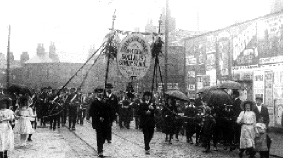 The earliest mill owners of much consequence in the town were the Sidebothams, in the cotton trade at Kingston from 1748. Steam power arrived in Hyde a few years later than in many factory towns but by 1820 all the new mills built in the town utilised steam rather than water power. Local coal was vital for the supply of these mills. Hyde was fortunate in lying on the South Lancashire coalfield (altogether of course the town was actually in Cheshire, the River Tame forming the county boundary). Many local cotton employers had shares in coal and Sidebothams and Ashtons owned their own mines.
The earliest mill owners of much consequence in the town were the Sidebothams, in the cotton trade at Kingston from 1748. Steam power arrived in Hyde a few years later than in many factory towns but by 1820 all the new mills built in the town utilised steam rather than water power. Local coal was vital for the supply of these mills. Hyde was fortunate in lying on the South Lancashire coalfield (altogether of course the town was actually in Cheshire, the River Tame forming the county boundary). Many local cotton employers had shares in coal and Sidebothams and Ashtons owned their own mines.
The centre of Hyde was not served by a railway until 1858, but Godley and Newton both had stations on the Manchester to Sheffield line, constructed in 1841. Hyde's growth had been especially enhanced by the Peak Forest Canal which was opened in 1800. In this period, Hyde was also served by Turnpike roads from Manchester to Stockport.
Social Unrest
Living and working conditions were certainly no worse in Hyde than in most of the cotton towns. The Ashtons who became the town's largest employers provided good facilities for their workers. Hyde played its part in the social unrest which was such a feature of the early 19th century. A seventeen year old Hyde youth was among those killed at the famous Peterloo Massacre at St. Peter's Field, Manchester in 1819. The murder of the young mill owner Thomas Ashton in 1831 by men in the pay of the Unions who were angry at their exclusion from Ashton's mills became national news. The town was a stronghold of the Chartist Movement which, from 1837-1848, posed a severe threat to public order with its demand for massive political reforms.
The Ashton Family
The Ashtons were among the earliest cotton pioneers in Hyde. From 1800 they worked as a family business with mills at Gerrards Wood and Wilson Brook at Godley. Six brothers were involved in the business which, as well as coal and cotton, also established the calico printing works at Newton Bank
In 1823 the brothers separated, Samuel and Thomas taking the major shares; the former establishing himself at Apethorn Mill and soon after building Woodley Mill, while Thomas ran the factory at the Hollow. The Ashtons were particularly noted for running mills that did both spinning and weaving, a successful practice when most mills concentrated on one process.
Thomas Ashton Jnr.
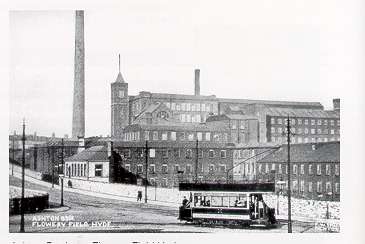 Thomas Ashton Jnr. was born in 1808 and ran his father's business with his elder brother from 1845. He continued his father's tradition of providing good conditions for this workers. The estate at Flowery Field was a testament to the Ashtons' work and they were amongst the first employers to provide day schools for their child workers.
Thomas Ashton Jnr. was born in 1808 and ran his father's business with his elder brother from 1845. He continued his father's tradition of providing good conditions for this workers. The estate at Flowery Field was a testament to the Ashtons' work and they were amongst the first employers to provide day schools for their child workers.
Thomas Ashton Jnr. was one of the most prominent Liberals in the North West but he always refused to stand for Parliament. It was, however, his son, the future Lord Ashton, who became the town's first MP in 1885. Thomas Ashton Jnr. earned particular note for his conduct during the Cotton Famine of 1861-5, keeping his mills running despite the high cost of cotton, and even managing to build a new mill at Throstle Bank, thus saving many of his employees from unemployment. Thomas Middleton talked of Ashton's 'high sense of public duty', and he certainly was active in numerous causes. He was President of the Mechanics Institute for five years, the founder of Hyde Sick Kitchen and a great promoter of local education.
It was no surprise that Ashton became Hyde's first Mayor on its incorporation as a borough in 1881. Two years later he laid the foundation stone for the impressive new Town Hall which opened in 1885. Thomas Ashton died in 1898, by which time his business employed thousands of people in three extremely modern mills. Of all the Hyde cotton firms the Ashton Brothers & Co Ltd have survived the longest. Not until 1968 were the mills taken over by Courtaulds.
The new town of Hyde was quick to provide modern facilities for its inhabitants including: in 1889 a Public Baths; in 1895 the Fire Station; in 1899 the Free Library and Technical School.
The Twentieth Century
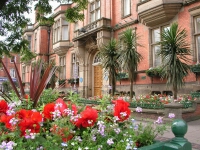 The major features in the development of Hyde in the present century are the considerable growth of municipal services and modernisation of the town, along with major changes in the town's industry.
The major features in the development of Hyde in the present century are the considerable growth of municipal services and modernisation of the town, along with major changes in the town's industry.
The early years of the century saw the opening of the park and new schools, including the County School on Clarendon Road. The period after the Great War saw a slump in the fortunes of the local cotton industry. By 1939, half of the town's mills had closed. One beneficial result, however, was the construction of Dowson Road, under an unemployment relief scheme. New industries had begun to appear in Hyde in the late 19th century and this process now considerably accelerated. By the 1930s, the town had a large range of industries including rubber, leather, engineering, ice cream, chemicals and glove works.
One of the towns most noted achievements came with the success of Hyde Seals water polo team who, in the period 1904-14, were the finest in the world, three times winning the world championships. Previously the town's most conspicuous sporting achievement was a rather negative one - her soccer team's 26-0 defeat by Preston North End in 1887 being the greatest defeat in an F.A. Cup match then or since. In 1930 all Hyde feted Frances Lockett who had won the first ever Cotton Queen contest which had been started in an attempt to boost the flagging fortunes of the trade. Despite this success Hyde was not able to escape a major collapse of the industry to which it owed its very existence.
Hyde has seen many changes in the post 1945 era, the new town centre and housing schemes, and the huge estate at Hattersley, being most conspicuous. In 1991 the town's population was 34,821.
Facts About Hyde
A comprehensive selection of historical photographs can be found at www.tameside.gov.uk/history
- Hyde Chapel was the first church to be erected in 1708. Previously, worshippers had to cross the River Tame to Denton or walk to Stockport. At this time Hyde consisted of a few scattered farms and a cluster of ten houses on Red Pump Street (now known as Market Street)!
- The Hare and Hounds pub on Werneth Low is the oldest licensed premises in the district. Records show that there was an inn here in 1794. It was once a farmhouse situated on the old Roman Road from Melandra, near Glossop, to Stockport. Between 1838 and 1850 horse racing was practised here. Walter Mansfield managed the inn from 1929 to 1983. When he took residence it was derelict; no water, electricity, or sanitation. Later Walter installed his own generator. His motto was "less talking, more drinking". During the 1960's and 1970's the hunt used to gather here on Boxing Day!
- Captain Clarke's Bridge spans the Peak Forest Canal in Hyde and was originally named Wood End Canal Bridge. It is said that the bridge was built to divert the horse traffic to the other side of the canal in order that the Hyde Clarke family would not be troubled by the barges!
- In 1815, twin boys were born to Mrs Smith who lived in Rock Street, Gee Cross. They were named Robin and Jam. All their life they went everywhere together. When they walked down the street one would walk behind the other treading in the footsteps of the first. They both dressed alike, no-one was sure which was which! After their brother and sisters left home and their parents died, they went to live in a cellar under the end house in Stone Row on Mottram Old Road. Then they were known locally as "the Cellar People". Jam died in 1889 and his brother in 1890. The following year, Hyde Carnival held a competition for the two best representations of the original Robin and Jam, the Gee Cross Twins, with £1.00 being offered for the prize!
- Thomas Ashton, mill-owner, was perhaps the most significant of the Ashton family of Hyde, who were involved in creating Hyde's cotton industry. He was responsible for founding one of the largest, and longest lived textile companies in Hyde, later known as Ashton Brothers. When he died in 1846, he left the business to his two surviving sons, Samuel and Thomas, along with the majority of his personal estate and property, which was worth just under £60,000. In 1854 Samuel and Thomas formed Ashton Brothers and Co out of their father's business, maintaining the business's position of one of the largest independent employers in the town until its sale in 1968.
- Harry Rutherford (1903-1985) was an artist of national repute, whose work included not only Tameside scenes but also embraced the worlds of the theatre, cinema and television. Although his career often took Rutherford away from Tameside, he always returned to his northern roots and was a familiar figure in Hyde.
It is hoped that in the future, an art gallery will be established in Hyde Town Hall, dedicated to Harry Rutherford, and displaying some of his paintings!
- Among the more notable figures of the present day are national politicians such as Barbara Castle, who was born in Hyde, and the second longest ever serving Tameside MP Rt. Hon. Tom Pendry who has represented the Hyde and Stalybridge constituency since 1970 and has been re-elected six times.
- Sited on the front of Hyde Town Hall, a blue plaque honours Joshua Bradley, born in a humble cottage in Further Lane, Hattersley.
- A blue plaque in honour of the history of the Cotton Tree Public House in Newton, Hyde was unveiled by the Rt. Hon. Jack Cunningham on Saturday, 18th December 1999.
- Arthur Herbert Procter did not become associated with Tameside until after his glorious military career. He was born in Bootle and educated at Port Sunlight and Exeter. His blue plaque is located at St Stephen's Church, Hyde.
- The Hyde Lane Colliery was a prosperous business in the late 1800's, the proprietors of the pit were Mr J.W. Sidebotham M.P for the Hyde Division and his brother Mr J. Nasmyth Sidebotham. The blue plaque is located on the Canal Towpath, off Manchester Road in Hyde.
- The blue plaque located on the former site of The Norfolk Arms, Hyde was unveiled in March 2001 in memory of those who died in "May's Downfall".
Places of Interest in Hyde
Werneth Low Country Park - Gee Cross Hyde
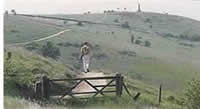 The "lowest" spur in the Pennine Chain, the Park is famed for its views. The Welsh hills are visible on a clear day. Greater Manchester opens up in the foreground and to the south and east the view is dominated by the Peak District. Whilst daytime views are breathtaking, the evening sunset and glowing lights of the North West conurbations are spectacular. After a nice stroll around the Park, why not go for hearty meal at the Hare and Hounds Public House.
The "lowest" spur in the Pennine Chain, the Park is famed for its views. The Welsh hills are visible on a clear day. Greater Manchester opens up in the foreground and to the south and east the view is dominated by the Peak District. Whilst daytime views are breathtaking, the evening sunset and glowing lights of the North West conurbations are spectacular. After a nice stroll around the Park, why not go for hearty meal at the Hare and Hounds Public House.
Newton Hall, Dukinfield Road, Hyde
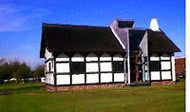 A fascinating 14th-century cruck-framed building which enables the visitor to see exactly how a medieval timber-framed hall was constructed. In Roman times there was a track that ran up the hill from the River Tame, just below the Hall, all the way to Melandra Castle near Glossop, which is about 3 miles to the east. Full details about the restoration are available from the Tourist Information Centre in Ashton.
A fascinating 14th-century cruck-framed building which enables the visitor to see exactly how a medieval timber-framed hall was constructed. In Roman times there was a track that ran up the hill from the River Tame, just below the Hall, all the way to Melandra Castle near Glossop, which is about 3 miles to the east. Full details about the restoration are available from the Tourist Information Centre in Ashton.
Tameside Leisure Pool
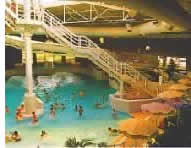 Situated at Hyde, the Leisure Pool is a water wonderland for all the family. The main Lagoon Pool has a gently shelving beach area, 80m water slide, wave machine, wild water channel, cannons, fountains and much more. The "Altered Images" Fitness Studio has hi-tech cardio-vascular and resistance training equipment and computer designed individual exercise programmes housed in a fully air-conditioned area. There's a Health Suite with sauna and steam rooms and the latest fast tanning equipment to enjoy, a poolside cafe and licensed bar. A floodlit stadium with an all weather synthetic pitch hosts a wide range of outdoor sports. For information on all Tameside’s leisure centres visit Active Tameside .
Situated at Hyde, the Leisure Pool is a water wonderland for all the family. The main Lagoon Pool has a gently shelving beach area, 80m water slide, wave machine, wild water channel, cannons, fountains and much more. The "Altered Images" Fitness Studio has hi-tech cardio-vascular and resistance training equipment and computer designed individual exercise programmes housed in a fully air-conditioned area. There's a Health Suite with sauna and steam rooms and the latest fast tanning equipment to enjoy, a poolside cafe and licensed bar. A floodlit stadium with an all weather synthetic pitch hosts a wide range of outdoor sports. For information on all Tameside’s leisure centres visit Active Tameside .

